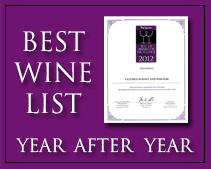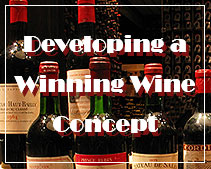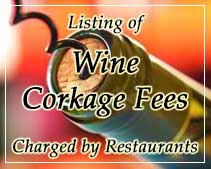History of the Riesling wine grape
February 15, 2011
History of the Riesling Grape
Knowledgeable wine drinkers have always known that the Riesling grape, grown in a few select places in Germany, produces some of the finest wines available. In terms of quality, delicacy, charm, and style, the German Riesling can compete with any wine produced in the world. Unfortunately, appreciation for the wine among the general wine drinking public is not now, nor has it ever been, as enthusiastic as it should be. The history of the grape is almost as much of an enigma as its lack of popularity.
The derivation of the word Riesling is still not clear. One theory connects it to the characteristics of the vine. For example, “Russ” means dark wood and the Riesling vine consists of strong dark wood; also the bark has deep grooves with the resultant root word “rissig”. The most likely connection is a negative characteristic of the Riesling, namely, its poor flowering propensity in cool weather which is described by the German words verrieseln or durchrieseln.
Its origin is a mystery, but it is believed that the grape is indigenous to Germany. Interest in the varietal probably began in the early fourteenth century with the gradual shift of plantings from red to white grapes. This tradition was slow and sporadic and continued until the seventeenth century when the monks ( how often monks have played a role in wine history is remarkable ) of the Cistercian monastery at Eberbach discovered that the transparent Rheingau reds could not compete with the deeply colored French wines. Consequently they ordered their tenant growers to use only white wine plantings and to remove all else. Exactly what variety of grape the monks wanted planted was not stated but it is believed to be Riesling since by this time the qualities of the grape had become known.
The first documented evidence we have of the varietal was a sale that took place on March 13, 1435. The cellar log of Count Katzenelnbogen at Ruesselsheim shows that Klaus Kleinfish sold the Count six vines of Riesling for 22 solidi. There are many other contenders for the honor of “first planting” ( the Wachau in Austria, Westhofen in Rheinhessen and the Alsace region all contend with dates of 1232, 1402, and 1348 respectively, to name just a few), but all this means is that from the mid�fourteenth century Riesling was becoming popular. In 1464 twelve hundred “Ruesseling” vines were purchased by the St. Jacob Hospice, today, part of the Vereinigte Hospitien of Trier. A specific vineyard in Worms “Ruessling hinder Kirssgarten” (Riesling behind the cherry orchard) was described in 1490, and a “Rissling wingart” at Pfeddersheim in the Rheinhessen in 1511, attests to the spread of the grape.
Evidently Hieronymus Bock was aware of the grape as a Latin version of his book on herbs (1552) describes it. Surprisingly the modern spelling of the word is used.(It is nice to speculate that his painting the “Garden of Delights” was in some ways inspired by an excessive but wonderful evening with Riesling wine.) A later version of this book (1577) stated that “Riesling was growing in the Mosel, the Rhein, and the environs of Worms”. By the seventeenth century “Ruessling”, according to a journal published in 1703, was planted throughout the Palatinate.
The most important development in the spread of Riesling as the “grape of Germany” took place at the Benedictine Abbey in Johannisberg in the Rheingau.In 1716 the Prince�Abbey of Fulda purchased the rundown priory. The vineyards, which were in total neglect, were completely restored and replanted with Riesling vines within five years. In 1720/21 294,000 vines were planted. The vines were purchased from Ruedesheim, Eberbach, and Floersheim, further indicating the extent of the grape. Schloss Johannisberg, of course, set the standards for the grape, and other areas soon decreed that Riesling should be the grape planted. In 1744, for example, the Bishop of Speyer, Cardinal Christoph von Hutten insisted upon the destruction of Elbling vines and the planting of Riesling. Even more important was the proclamation of Clemens Wenzeslaus, Elector of Trier, on May 8,1787 that all inferior vines be dug up and replanted with noble varietals. He meant Riesling, and the Mosel�Saar�Ruwer area celebrates this year as the bi�centennial of the Wenzeslaus pronouncement.
The examples of Johannisberg and Wenzeslaus started a Riesling boom in the Rheingau and the Mosel. The wines were so successful that by the turn of the century the Benedictine Monk Odo Staab at Johannisberg, could claim that “other than Riesling no other varietal should be used to produce wines in the Rheingau.” By the end of the 19th century it was the dominant grape in the Rheingau, and it had made significant inroads in all other growing areas of Germany.
Sadly, a reversal of this trend began in the early 20th century as German growers, spurred by new trends in science, began experimenting with various varietals such as Silvaner. By 1930, only 57% of the vines planted in the Rheingau were Riesling. Today this trend has been reversed for all the significant classic vineyards in Germany. The areas were Riesling produces superior wines such as the Rheingau and the Mosel�Saar�Ruwer are now, once again, being recognized as having an important historical and viticultural place in Germany. Consequently, wine grower in these and other areas have joined together to decree that Riesling is the great wine grape of Germany. By far the most significant of these groups is V.D.P.(the association of German Predicate and Quality wine producers), a collection of growers dedicated to producing only the finest wines. Pro�Riesling is a new organization that includes many V.D.P. members. As spokesmen for the Riesling, these producers wines are the best advertisements for what Riesling is all about.
Recognition for the quality of the Riesling grape must continue to grow. It should be considered a national treasure and accorded the same status in Germany and the rest of the world as the Pinot Noir and Chardonnay grapes of Burgundy and the Cabernet Sauvignon grape of Bordeaux. Perhaps, with the continual efforts of growers such as the V.D.P. the rest of the wine world will recognize the treasures this grape is capable of producing.
Riesling is a varietal whose time has come. Appealing to the novice wine drinker, its wines should be of even greater interest to the connoisseur. It offers the palate a wine of great delicacy and finesse with a nerviness and piercing quality that only Riesling can deliver. Each growing area of Germany imparts its own special character and attributes to the Riesling. In great vintages the Saar and Ruwer produce spectacularly aristocratic white wines that have no peer. On the Mosel the wines are wonderfully floral and supremely elegant. Rheingau Riesling is more substantial, more masculine but also very fine. Nahe Riesling offers the crisp acidity and liveliness of a Mosel but also the firm body of a Rheingau. The Middle Haardt of the Pfalz offers Rieslings that are rich, plump and taste of apricots, peaches and honey. In Franconia, W�rttemberg and Baden the wines are full-bodied and earthy. With the higher potential alcohol the wines are usually finished dry. Jancis Robinson in her book “VINES, GRAPES and WINES” puts it very well indeed: “Riesling produces wines of unbeatable quality, wines that are indisputably aristocratic and ludicrously unfashionable”.
Source: http://www.rudiwiest.com/knowledge/history_riesling.htm
The wine shop in Angeles Philippines Clark Freeport Zone Pampanga as well as other wine shops, wine bars and wine outlets in Subic and Manila are wells stocked with interesting selections of RIESLING wine from many vintages spanning over 90 years from various producers covering a wide range of prices.
As a wine collector, hobbyist or someone in the wine trade, are you concerned or interested about this also? If so, please stay tuned in to Yats Wine Cellars’ web site to stay abreast of things to do with wine in the world.
News and pertinent information about wine trade, wine appreciation, wine shops and outlets, wine and food pairing, wine making, viticulture, vintages, climate conditions affecting wine, new and revived wine regions etc can be found here in this section. Yats wine Cellars is much more than a Philippines wine supplier with a few wine shops, wine bars and wine outlets in Philippines where clients can buy good wines in Manila, Angeles City, Subic and Clark Philippines. Yats Wine Cellars is also a rich source of information for the convenience of the growing community of wine lovers, wine connoisseurs and hobbyists. Wine lovers in Manila, Subic, Angeles City, Clark Philippines can enjoy fine vintage wines in any of Yats Wine Cellars wine shopping outlets, wine bars, wine shops and wine restaurants.
You are welcome to post your comments and questions about any topic related to wine on www.YatsWineCellars.com or email Wine@Yats-International.com with your comments, suggestions, questions, purchases or inquiries on wine and wine-related topics.
Leading Philippines Wine Supplier Yats Wine Cellars based in Clark Philippines with outlets in Angeles City, Subic Freeport and Manila Philippines has been not only a wine shop for fine wines covering all major wine regions but also a source of reliable and useful information about wine, wine appreciation, wine accessories, wine and health, food and wine pairing and all other matters relating to wine and its appreciation. This Philippines Clark Freeport based Wine Supplier and Wine Shop frequently holds public wine tasting events in Pampana Clark Freeport Zone, Angeles City, Subic Bay area, Makati, Fort Bonifacio and other areas in Philippines capital city Manila. Private Wine events such as private wine tasting and private wine dinners are also designed and organized for private clientele for their wine loving guests.
Wine Catering is a unique product of Yats Wine Cellars, created back in 2005 in response to a growing demand for private wine parties in Manila, Cebu, Subic, Angeles Clark Philippines.
Chateau Lafite-Rothschild is the most revered wine in China and many other parts of Asia. The best wine shop in Asia to buy older vintages of Chateau Lafite is Yats Wine Cellars located in Clark Philippines. Aside from Lafite, visitors can buy other fine wines at this wine shop in Clark Pampanga such as Latour, Mouton-Rothschild, Haut-Brion and Margaux. Excellent Burgundy wines like Chambertin, Vougeot, Musigny, Bonnes Mares, Pommard, Meursault, Chambertin, Vosne Romanee, Romanee Conti, La Tache and Romanee St. Vivant can be found here.
Yats Wine Cellars can be reached at their Clark Wine Center Philippines wine shop located on the main highway M A Roxas of Pampanga Clark Freeport Zone or their sales office in Ortigas Centre, Metro Manila. Here is the contact information:
Clark Wine Center
Bldg 6460 Clark Observatory Building
Manuel A. Roxas Highway corner A Bonifacio Ave,
Angeles Clark Freeport Zone, Pampanga 2023
0922-870-5173 0917-826-8790 (ask for Ana Fe)
YATS Wine Cellars
Manila Sales Office
3003C East Tower, Phil Stock Exchange Center,
Exchange Rd Ortigas Metro Manila, Philippines 1605
(632) 637-5019 0917-520-4393 ask for Rea or Chay
Best place to buy wine in Clark Pampanga outside Manila near Subic and Angeles City Philippines is Clark Wine Center.
Wedding couples looking for wedding reception venues and beach wedding venues can log on to this Philippines Wedding Venue web site for free information and assistance:
http://www.PhilippinesWeddingVenue.com
While in Clark, it might be a good idea to enjoy an evening of wine-and-dine in the fine dining Yats Restaurant and Wine Bar that features an award winning 2700-line wine list. It is located in Mimosa Leisure Estate of Clark Freeport Zone. For more information, visit http://www.YatsRestaurant.com
YATS Leisure Philippines is a developer and operator of clubs, resorts and high-class restaurants and wine shops in Clark Angeles Philippines http://www.yatsleisure.com
Looking for famous tourists spots, places to visit and see, relax and unwind in Clark, Pampanga, Philippines? You may want to check out these sites also:
http://www.HotelClarkPhilippines.com
http://www.ClarkPhilippines.com
http://www.YatsWineCellars.com
You can skip to the end and leave a response. Pinging is currently not allowed.







